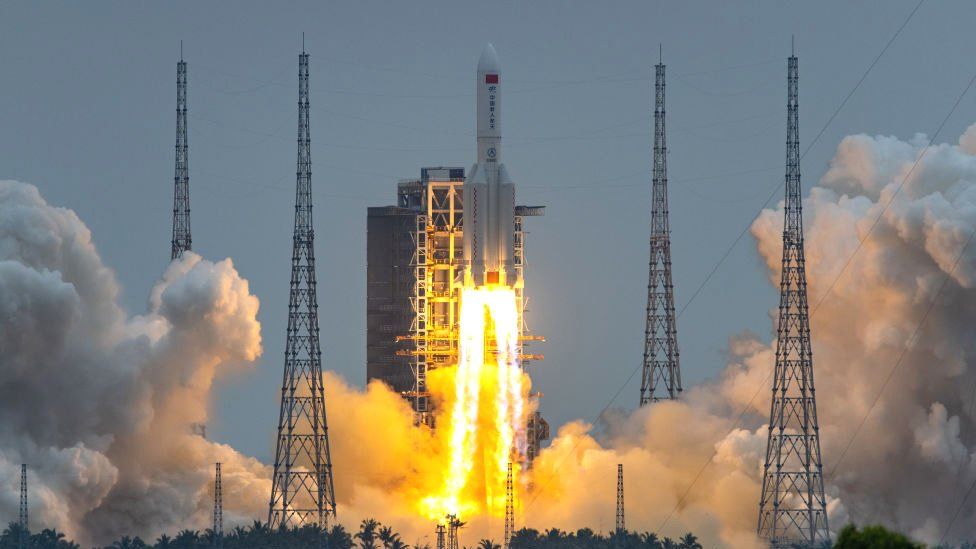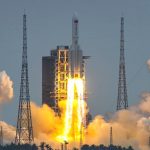There is anxiety in Nigeria’s capital Abuja over reports that debris from a Chinese Long March-5b rocket used to launch the first module of China’s new space station last month could hit the Federal Capital Territory (FCT) Abuja this weekend.
The 18 tonnes Chinese rocket, one of the largest items in decades to have an undirected dive into the atmosphere, will have and unusual uncontrolled re-entry.
Originally injected into an elliptical orbit approximately 160 kilometres by 375 kilometres above Earth’s surface on 29 April, the Long March-5b core stage has been losing height ever since.
Most of the vehicle should burn up when it makes its final plunge through the atmosphere, although there is always the possibility that metals with high melting points, and other resistant materials, could survive to the surface.
When a similar core stage returned to Earth a year ago, piping assumed to be from the rocket was identified on the ground in Ivory Coast, Africa.
The chances of anyone actually being hit by a piece of space junk are very small, not least because so much of the Earth’s surface is covered by ocean, and because that part which is land includes huge areas that are uninhabited.
The zone of potential fall in this case is restricted still further by the trajectory of the rocket stage. It’s moving on an inclination to the equator of about 41.5 degrees. This means it’s possible already to exclude that any debris could fall further north than approximately 41.5 degrees North latitude and further south than 41.5 degrees South latitude.
The US on Thursday said it was watching the path of the object but currently had no plans to shoot it down.
“We’re hopeful that it will land in a place where it won’t harm anyone,” US Defense Secretary Lloyd Austin said. “Hopefully in the ocean, or someplace like that.”
Various space debris modelling experts are pointing to late Saturday or early Sunday (GMT) as the likely moment of re-entry. However, such projections are always highly uncertain.
China has played down fears that the Long March 5B rocket could hit a populated area or a plane in flight but there is no shortage of problem debris in orbit.
The Chinese government, perhaps predictably, is playing it calmly. “The probability of causing harm to aviation activities or [on people and activities] on the ground is extremely low,” the foreign ministry spokesman, Wang Wenbin, said on Friday.
But the fiery fate of the booster, wherever it comes down, speaks to the larger issue of space debris and space sustainability, especially as space becomes a target not just for national space programs but also increasingly the private sector. Under international treaty, private space actors, who are expected to put 45,000 satellites in low Earth orbit over the next several years, are under the legal responsibility of their host nations.
Add to that, an estimated 9,300 tons of space junk that’s already orbiting the planet and the issue of space collisions and debris pollution is an issue of concern.
Last month, mission controllers at SpaceX headquarters in California warned orbiting astronauts to put on their spacesuits and get back in their seats because a piece of space debris could strike the capsule. Previously, a piece of paint the size of a fingernail struck the windscreen of a space shuttle, piercing two of three layers of glass.
“Space debris has been known for a while, but now you have more competition in space. You don’t just have two space-faring nations – the Chinese are very significant, as is the European Space Agency, among others. When you have more actors and more stuff, it gets more complicated,” said Joanne Gabrynowicz a professor at the National Center for Remote Sensing, Air, and Space Law at the Mississippi Law Center.
Experts have repeatedly voiced their worry about the risk of collisions since 2009, when two satellites – Iridium 33 and the derelict Russian military Kosmos-2251 –accidentally collided at 26,000mph over Siberia, shattering both in thousands of pieces. The European Space Agency hosted a major conference on the subject last month.
“There’s a lot of stuff being put into low Earth orbit, and some of it could possibly hit one another,” said Gabrynowicz.
According to Jonathan McDowell, an astrophysicist at the Harvard-Smithsonian Center for Astrophysics, China had every reason to know Long March 5B was unpredictable and would become uncontrollable. “It’s my judgment that the Chinese are negligent. China says it will probably fall in the ocean. But probably is doing a lot of work here. The last one would probably fall in the ocean, except it didn’t. It fell on the Ivory Coast,” he said.
The fate of Long March 5B could refocus governments and international bodies on the issue of space sustainability, and that could provide more opportunity to firms like UK-based Astroscale that are preparing to tackle the debris problem with commercial junk-collecting services.
According to the European Space Agency, about 6,900 of 11,370 satellites placed into Earth orbit are still circulating, with about 4,000 functioning. But the number of debris objects regularly tracked by Space Surveillance Networks stands at 28,160. The discrepancy is accounted for by more than 560 “break-ups, explosions, collisions, or anomalous events resulting in fragmentation”.
Astroscale is currently demonstrating a vehicle called “ELSA-d” in lower Earth orbit to show that space debris clean-up is indeed possible. It’s a fiendishly difficult task, especially if the target satellite is spinning and tumbling. The test is using a satellite to capture a test drone using a magnet; in time, larger objects will require a robotic arm.
The company’s managing director, John Auburn, said the real problem might not be the big pieces of debris that create the headlines and cause people back on ground to cast a nervous eye in the skies.
“The big problem in space is not big debris, but when big debris breaks up and becomes small debris,” Auburn said. “A one-centimetre fragment can destroy your spacecraft and it’s traveling so fast you don’t know it’s there from the ground. We don’t want a disaster, so it’s very important that governments build into licences requirements that old and broken stuff is brought back down.”





